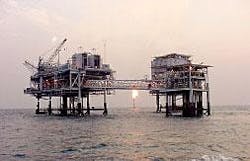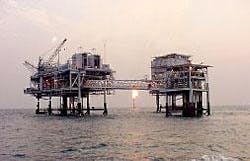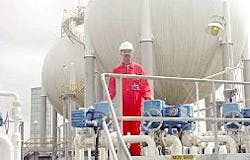ChevronTexaco Corp.'s investments in Nigeria are increasingly focused on development, utilization, and marketing of that country's vast natural gas resources.
The growing importance of monetizing Nigerian gas is positioning the major oil exporter also as an exporter of gas and gas products to be reckoned with. And domestic demand for natural gas is escalating in Nigeria and elsewhere in Africa as an alternative to burning wood and biomass. Nigeria has targeted an end to all gas flaring by 2008.
ChevronTexaco was one of the first major oil companies to pursue gas utilization in Nigeria, beginning with the Escravos gas gathering, utilization, and liquids fractionation project (EGP). Most recently, the company has committed to participate in the Brass River LNG export project along with Nigeria Agip Oil Co., ConocoPhillips, and state- owned Nigerian National Petroleum Corp. (NNPC). ChevronTexaco also is pursuing a major gas-to-liquids (GTL) project in Nigeria.
But capturing the most attention at present is the West African Gas Pipeline (WAGP) project. ChevronTexaco contends the WAGP project will serve as Nigeria's contribution to energy integration in Africa and thus foster regional interdependence and political cooperation (see related story, p. 30).
null
WAGP details
WAGP involves the transport of natural gas supplies from Nigeria to power generators and industrial customers in Ghana, Benin, and Togo. The project calls for the installation of 617 km of offshore pipeline and 57 km of onshore pipeline from an offtake at an existing natural gas system near Lagos. The project is estimated to cost $550 million, including pipeline installation and metering, pressure regulation, gas scrubbing, and compression facilities. It would have a throughput capacity of 450 MMscfd. WAGP is being undertaken by a joint venture project of NNPC, ChevronTexaco West African Gas Pipeline Co. Ltd., Shell Overseas Holdings Ltd., and Takoradi Power Co. Ltd.
The tie-in point is an existing Nigeria-owned, 24-in. (ANSI Class 600) flange on the Escravos-Lagos pipeline at Alagbado Tee, Itoki, west of Lagos. The proposed onshore pipeline (30 in., ANSI Class 600) extends from the Alagbado Tee tie-in point and proceeds 57 km overland to a new compressor station to be located at Lagos Beach, Nigeria. After compression, the offshore pipeline segment (20 in., ANSI Class 900) starts and extends offshore 15 km before turning west.
The offshore pipeline route extends an additional 560 km while maintaining a 15 km standoff from the coast before ending at Takoradi, Ghana. Along the base route, additional lateral spurs, averaging 15 km, will extend from the base pipeline route to landfall regulating and metering facilities at Cotonou, Benin, Lome, Togo, and Tema, Ghana. Further extensions and expansions may be added to the project if shown to be commercially viable. The maximum water depth for all offshore pipelines is expected to be less than 100 m. It is planned that the first gas supply will flow through the WAGP system during second or third quarter 2005.
Gas utilization
To achieve its goal of zero flaring within the next 5 years, Nigeria has secured commitments from Nigeria's major operators that will dramatically boost the country's output of sales gas.
In addition to ChevronTexaco's EGP Phase 2, the major contributors to Nigeria's gas utilization program will be gas production from Shell Petroleum Development Co.'s oil fields and related facilities: Bonny Island nonassociated gas plant, Soku field gas plant, and associated gas from Forcados, Cawthorne, Ekulama, Belema, Odeama Creek, Nembe Creek, OGGS/EA, and Obigbo AGG oil fields.
ChevronTexaco commenced first-phase operations at the Escravos gas gathering project in 1997. EGP Phase 1 processes 165 MMcfd of associated natural gas, which is then supplied to the domestic market by pipeline.
EGP Phase 2, which processes an additional 135 MMcfd of gas, began operations in late 2000. The gas is currently used domestically. It is planned that gas from EGP 2 will be exported to Benin, Togo, and Ghana through the WAGP.
EGP Phase 3 will increase inlet capacity at Escravos by 400 MMcfd of natural gas from ChevronTexaco's offshore and onshore swamp oil production facilities. Gas from EGP-3 will serve as feedstock for the Escravos GTL (EGTL) plant, scheduled to come online in 2007.
EGTL will utilize technologies developed by Chev- ronTexaco and Sasol Ltd. of South Africa and will initially produce 34,000 b/d of premium GTL fuel and naphtha products to be marketed in Europe.
Gas distribution, exports
Also critical to Nigeria's efforts to monetize its gas resources are a number of gas distribution and export schemes.
Nigeria has quickly ramped up its LNG exports from the Nigeria LNG Ltd. Bonny Island facility, where Trains 4 and 5 are under construction and a sixth is under consideration. Partners are NNPC, Shell, Agip, and Total SA.
At least three other Nigerian LNG export schemes are under consideration, including the Brass River project (OGJ, June 30, 2003, p. 64); the West Niger Delta project backed by ChevronTexaco, ExxonMobil Corp., and Conoco- Phillips; and a floating LNG project sponsored by ChevronTexaco, Total, and Statoil ASA.
null
And future gas supplies may come from ExxonMobil's Oso condensate project, where condensate and NGLs currently are produced while associated gas is reinjected.
Several new gas distribution projects to promote Nigerian consumption of natural gas are also on tap:
- The proposed $580 million Ajaokuta-Abuja-Kaduna pipeline to supply natural gas to central and northern Nigeria.
- The proposed Aba-Enugu pipeline to deliver natural gas to parts of eastern Nigeria.
- The Lagos state government and Gaslink Nigeria Ltd. pilot program to deliver natural gas to nine residential neighborhoods in Lagos state.
- The Shell and Nigerian Gas Co. (NGC) Agbara-Ota industrial gas supply program in Ogun state.
- The NNPC-NGC bid to supply gas through the Escravos-Lagos pipeline into Lagos.



